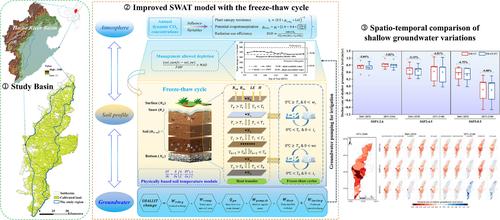增强的冻融循环改变了中国温带重灌溉盆地的地下水动态模拟
IF 4.6
1区 地球科学
Q2 ENVIRONMENTAL SCIENCES
引用次数: 0
摘要
随着全球变暖的加剧,有必要准确量化季节性冰冻地区的水文过程,尤其是灌溉越冬作物的水文过程,以制定促进地下水保护的管理策略。通过在水土评估工具(SWAT-FT)模型中加入基于物理的冻融循环模块,系统评估了华北平原在 2041-2070 年和 2071-2100 年三种共享社会经济路径下,传统 SWAT 模型和改进 SWAT 模型的地表水文和地下水动态变化。与传统 SWAT 模型相比,SWAT-FT 模型预测冬小麦生长季节土壤含水量增加、灌溉减少、渗漏增加。这些差异导致 SWAT 模型模拟的浅层地下水位下降率比 SWAT-FT 模型高出 5%。此外,SWAT-FT 模型预测,与历史时期相比,2071-2100 年期间浅层地下水水位的平均下降率分别约为 0.90 ± 0.16 m/yr-1(SSP1-2.6)、0.60 ± 0.46 m/yr-1(SSP2-4.5)和 -0.17 ± 0.53 m/yr-1(SSP5-8.5)。SWAT-FT 模拟结果表明,在 SSP5-8.5 情景下,浅层地下水位的下降率预计将缓慢下降,或者到 21 世纪末有可能上升,从而有可能实现浅层地下水开采和补充之间的平衡。我们的研究强调,在有越冬作物的温带地区,必须考虑冻融过程,以更准确地评估地下水变化对气候变化影响的响应。本文章由计算机程序翻译,如有差异,请以英文原文为准。

Enhanced Freeze-Thaw Cycle Altered the Simulations of Groundwater Dynamics in a Heavily Irrigated Basin in the Temperate Region of China
With intensified global warming, accurate quantification of hydrological processes in seasonally frozen regions, particularly with irrigated overwinter crops, is necessary to develop management strategies that promote groundwater conservation. By incorporating a physically based freeze-thaw cycle module into the Soil and Water Assessment Tool (SWAT-FT) model, variations of surface hydrology and groundwater dynamics were systematically assessed in North China Plain under three Shared Socioeconomic Pathways during 2041–2070 and 2071–2100 periods between the conventional and improved SWAT models. Compared to the conventional SWAT model, the SWAT-FT model predicted an increase in soil water content, decrease in irrigation, and an increase in percolation during the growing season of winter wheat. These discrepancies resulted in a 5% higher decline rates of shallow groundwater levels simulated by the SWAT model compared to the SWAT-FT. Additionally, the SWAT-FT model projected that the average decline rates of shallow groundwater levels were approximately 0.90 ± 0.16 m yr−1 (SSP1-2.6), 0.60 ± 0.46 m yr−1 (SSP2-4.5), and −0.17 ± 0.53 m yr−1 (SSP5-8.5), respectively, during 2071–2100 compared to the historical period. The SWAT-FT simulations indicated that the decline rates in shallow groundwater levels were projected to either decrease slowly or potentially increase by the end of the 21st century under the SSP5-8.5 scenario, potentially achieving equilibrium between shallow groundwater extraction and replenishment. Our study emphasized the importance of considering the freeze-thaw processes to evaluate groundwater variations more accurately in response to climate change effects in temperate regions with an overwinter crop.
求助全文
通过发布文献求助,成功后即可免费获取论文全文。
去求助
来源期刊

Water Resources Research
环境科学-湖沼学
CiteScore
8.80
自引率
13.00%
发文量
599
审稿时长
3.5 months
期刊介绍:
Water Resources Research (WRR) is an interdisciplinary journal that focuses on hydrology and water resources. It publishes original research in the natural and social sciences of water. It emphasizes the role of water in the Earth system, including physical, chemical, biological, and ecological processes in water resources research and management, including social, policy, and public health implications. It encompasses observational, experimental, theoretical, analytical, numerical, and data-driven approaches that advance the science of water and its management. Submissions are evaluated for their novelty, accuracy, significance, and broader implications of the findings.
 求助内容:
求助内容: 应助结果提醒方式:
应助结果提醒方式:


